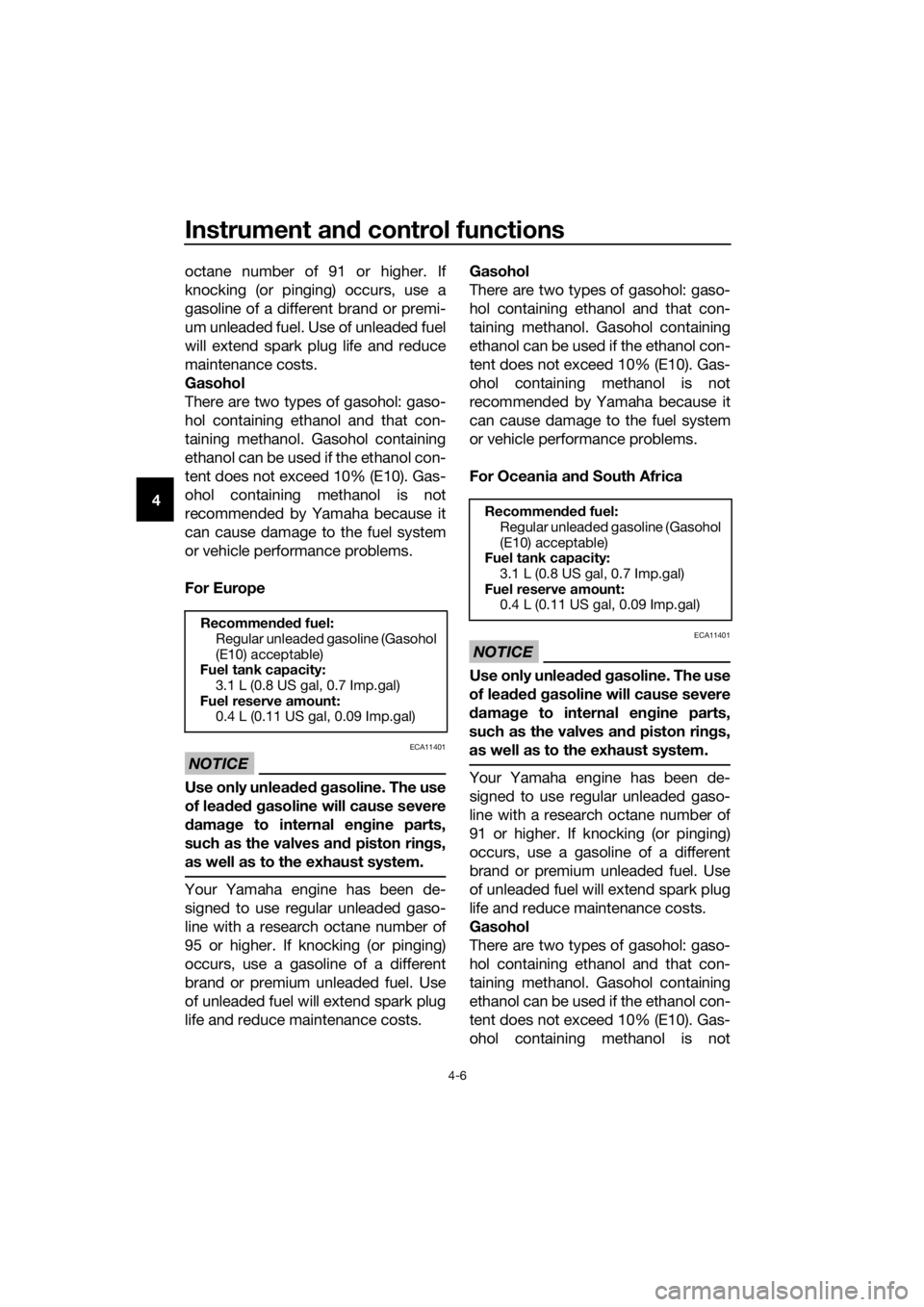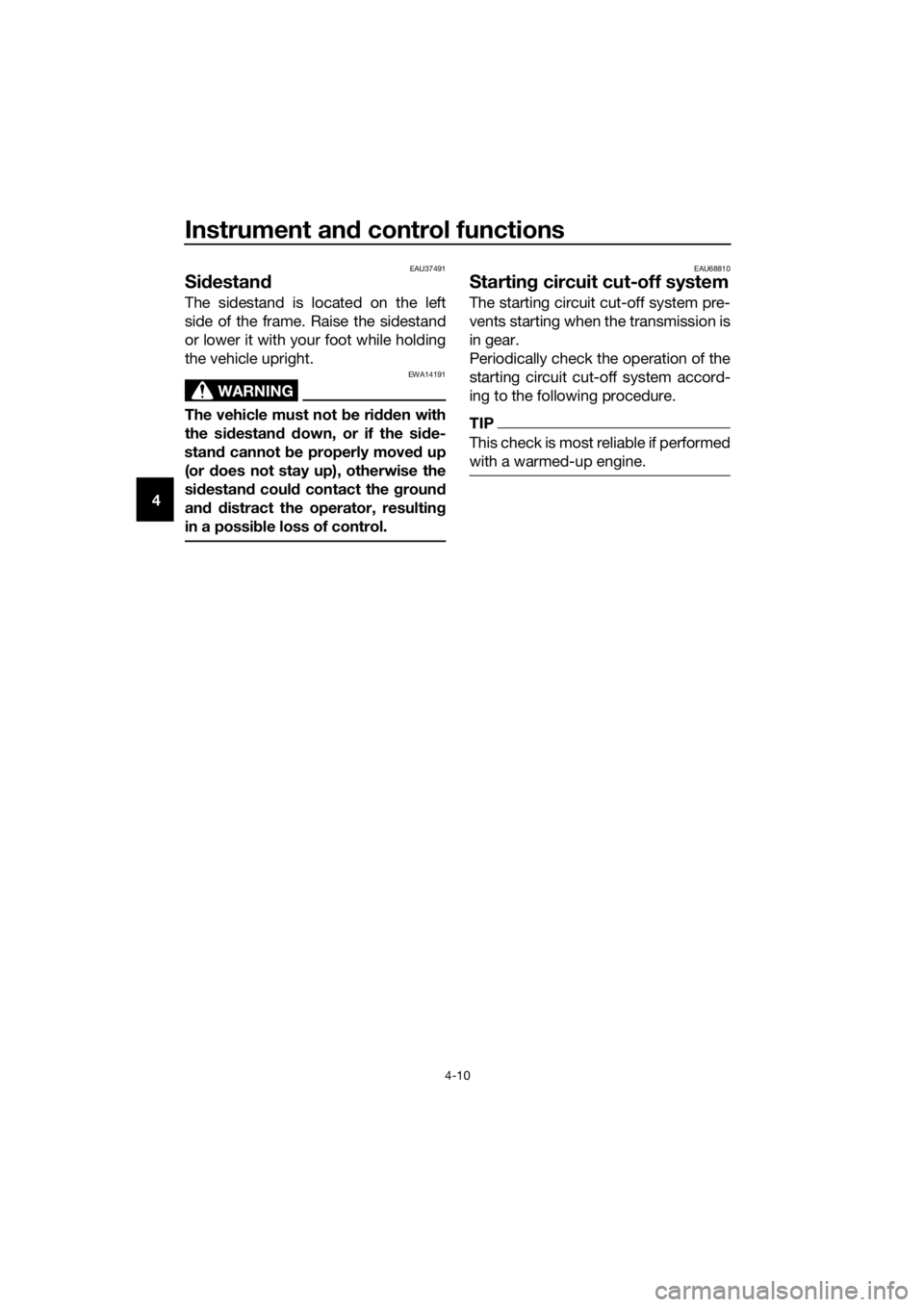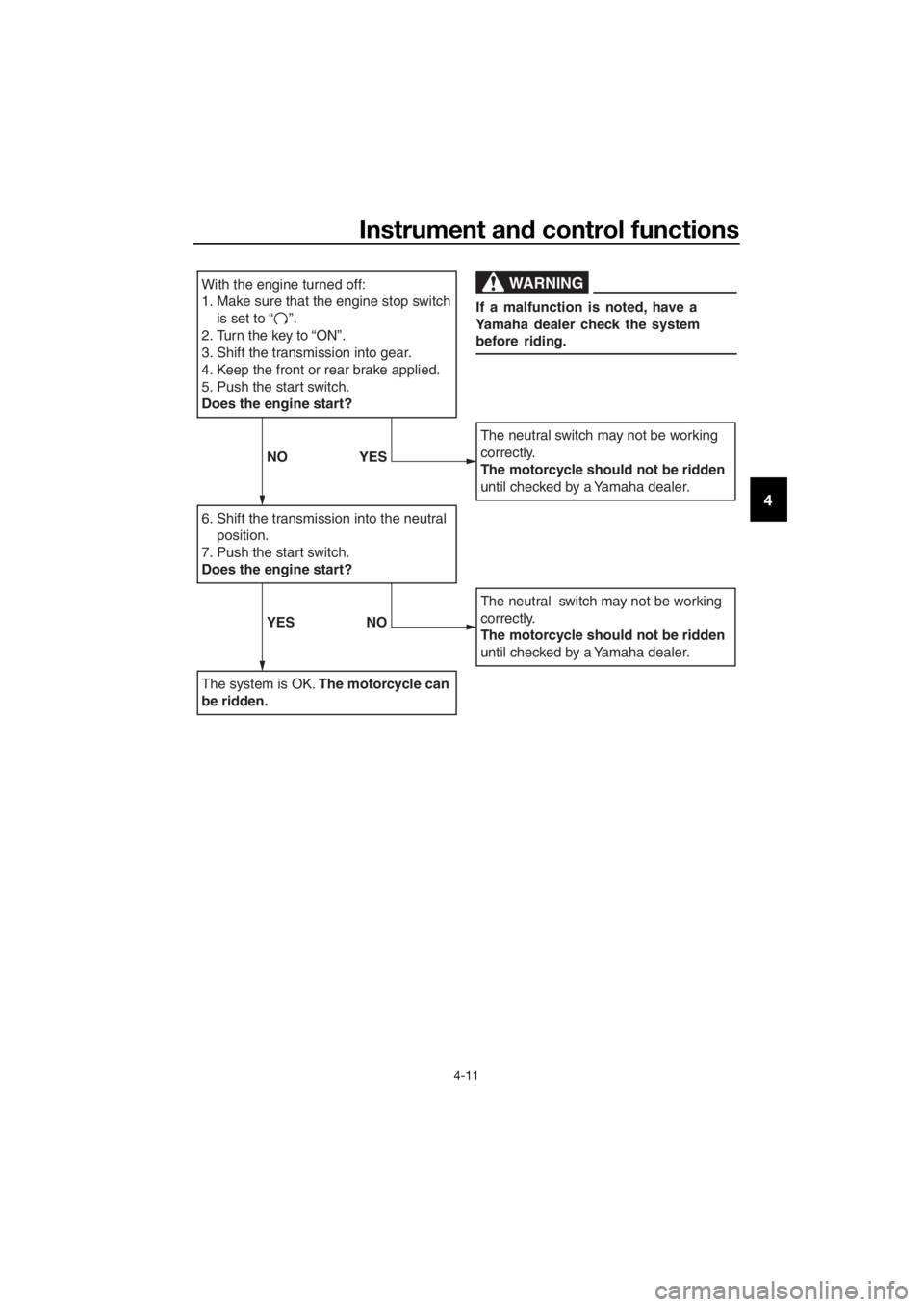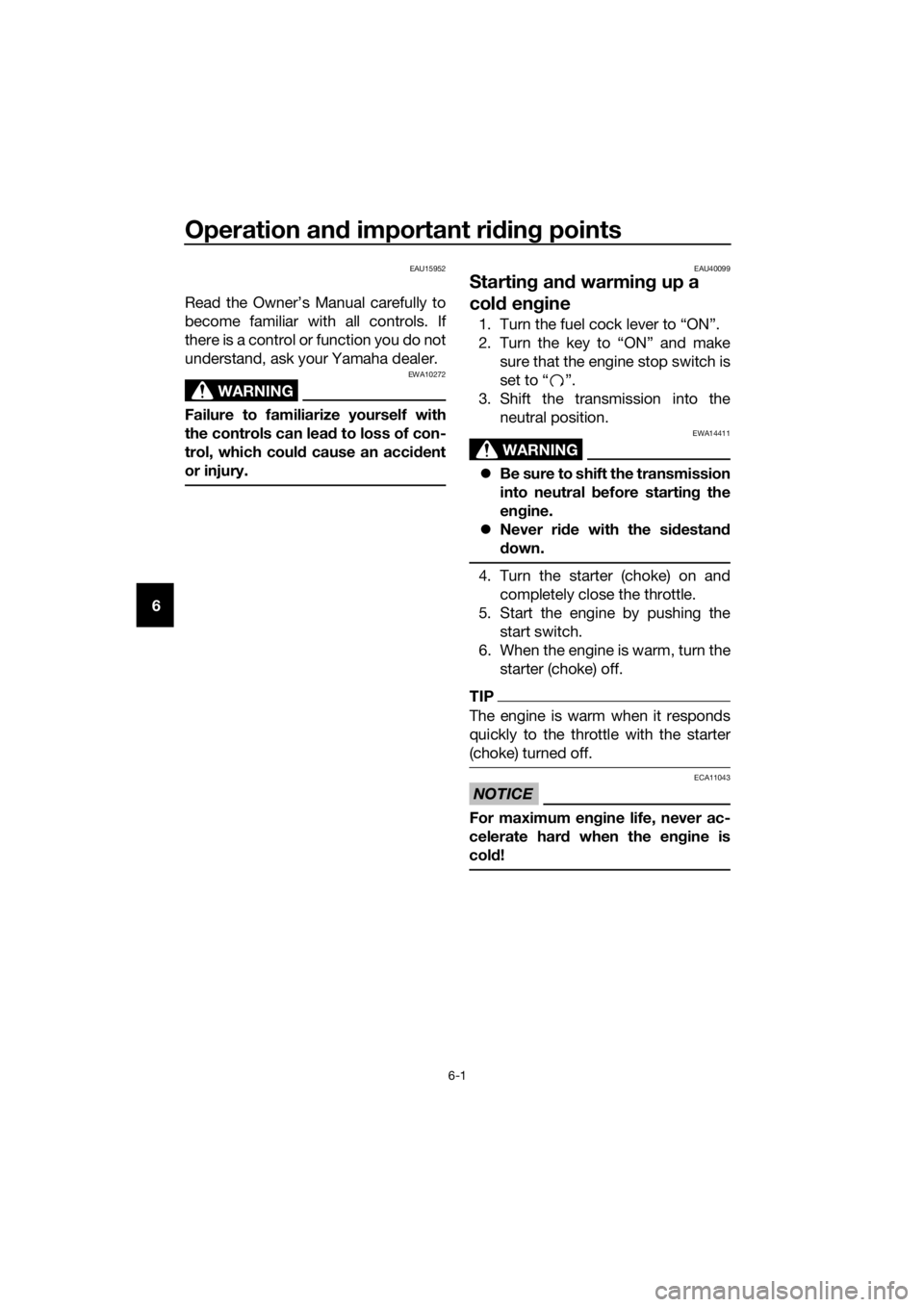YAMAHA TT-R50E 2016 Owner's Guide
Manufacturer: YAMAHA, Model Year: 2016, Model line: TT-R50E, Model: YAMAHA TT-R50E 2016Pages: 90, PDF Size: 1.97 MB
Page 31 of 90

Instrument and control functions
4-5
4
EAU13213
Fuel
Make sure there is sufficient gasoline in
the tank.
WARNING
EWA10882
Gasoline an d gasoline vapors are
extremely flamma ble. To avoi d fires
an d explosions an d to re duce the
risk of injury when refuelin g, follow
these instructions.
1. Before refueling, turn off the en- gine and be sure that no one is sit-
ting on the vehicle. Never refuel
while smoking, or while in the vi-
cinity of sparks, open flames, or
other sources of ignition such as
the pilot lights of water heaters
and clothes dryers.
2. Do not overfill the fuel tank. Stop filling when the fuel reaches the
bottom of the filler tube. Because
fuel expands when it heats up,
heat from the engine or the sun
can cause fuel to spill out of the
fuel tank.
3. Wipe up any spilled fuel immedi- ately. NOTICE: Immediately
wipe off spille d fuel with a clean, d
ry, soft cloth, since fuel may
d eteriorate painte d surfaces or
plastic parts.
[ECA10072]
4. Be sure to securely close the fuel tank cap.
WARNING
EWA15152
Gasoline is poisonous an d can cau-
se injury or death. Han dle gasoline
with care. Never siphon gasoline by
mouth. If you shoul d swallow some
g asoline or inhale a lot of gasoline
vapor, or get some g asoline in your
eyes, see your doctor imme diately. If
g asoline spills on your skin, wash
with soap an d water. If gasoline
spills on your clothin g, chan ge your
clothes.
EAU50254
For Cana da
NOTICE
ECA11401
Use only unlea ded g asoline. The use
of lead ed g asoline will cause severe
d amag e to internal en gine parts,
such as the valves an d piston rin gs,
as well as to the exhaust system.
Your Yamaha engine has been de-
signed to use regular unleaded gaso-
line with a pump octane number
[(R+M)/2] of 86 or higher, or a research
1. Fuel tank filler tube
2. Maximum fuel level
Recommen ded fuel:
Regular unleaded gasoline (Gasohol
(E10) acceptable)
Fuel tank capacity: 3.1 L (0.8 US gal, 0.7 Imp.gal)
Fuel reserve amount:
0.4 L (0.11 US gal, 0.09 Imp.gal)
U2CJ83E0.book Page 5 Friday, June 26, 2015 10:36 AM
Page 32 of 90

Instrument and control functions
4-6
4 octane number of 91 or higher. If
knocking (or pinging) occurs, use a
gasoline of a different brand or premi-
um unleaded fuel. Use of unleaded fuel
will extend spark plug life and reduce
maintenance costs.
Gasohol
There are two types of gasohol: gaso-
hol containing ethanol and that con-
taining methanol. Gasohol containing
ethanol can be used if the ethanol con-
tent does not exceed 10% (E10). Gas-
ohol containing methanol is not
recommended by Yamaha because it
can cause damage to the fuel system
or vehicle performance problems.
For Europe
NOTICE
ECA11401
Use only unlea
ded g asoline. The use
of lea ded g asoline will cause severe
d amag e to internal en gine parts,
such as the valves an d piston rin gs,
as well as to the exhaust system.
Your Yamaha engine has been de-
signed to use regular unleaded gaso-
line with a research octane number of
95 or higher. If knocking (or pinging)
occurs, use a gasoline of a different
brand or premium unleaded fuel. Use
of unleaded fuel will extend spark plug
life and reduce maintenance costs. Gasohol
There are two types of gasohol: gaso-
hol containing ethanol and that con-
taining methanol. Gasohol containing
ethanol can be used if the ethanol con-
tent does not exceed 10% (E10). Gas-
ohol containing methanol is not
recommended by Yamaha because it
can cause damage to the fuel system
or vehicle performance problems.
For Oceania an
d South Africa
NOTICE
ECA11401
Use only unlea ded g asoline. The use
of lead ed g asoline will cause severe
d amag e to internal en gine parts,
such as the valves an d piston rin gs,
as well as to the exhaust system.
Your Yamaha engine has been de-
signed to use regular unleaded gaso-
line with a research octane number of
91 or higher. If knocking (or pinging)
occurs, use a gasoline of a different
brand or premium unleaded fuel. Use
of unleaded fuel will extend spark plug
life and reduce maintenance costs.
Gasohol
There are two types of gasohol: gaso-
hol containing ethanol and that con-
taining methanol. Gasohol containing
ethanol can be used if the ethanol con-
tent does not exceed 10% (E10). Gas-
ohol containing methanol is not
Recommen ded fuel:
Regular unleaded gasoline (Gasohol
(E10) acceptable)
Fuel tank capacity:
3.1 L (0.8 US gal, 0.7 Imp.gal)
Fuel reserve amount: 0.4 L (0.11 US gal, 0.09 Imp.gal)
Recommen ded fuel:
Regular unleaded gasoline (Gasohol
(E10) acceptable)
Fuel tank capacity:
3.1 L (0.8 US gal, 0.7 Imp.gal)
Fuel reserve amount: 0.4 L (0.11 US gal, 0.09 Imp.gal)
U2CJ83E0.book Page 6 Friday, June 26, 2015 10:36 AM
Page 33 of 90

Instrument and control functions
4-7
4
recommended by Yamaha because it
can cause damage to the fuel system
or vehicle performance problems.
EAU13414
Fuel tank
breather hose
Before operating the motorcycle:
Check the fuel tank breather hose
connection.
Check the fuel tank breather hose
for cracks or damage, and replace
it if necessary.
Make sure that the fuel tank
breather hose is not blocked, and
clean it if necessary.
1. Fuel tank breather hose
U2CJ83E0.book Page 7 Friday, June 26, 2015 10:36 AM
Page 34 of 90

Instrument and control functions
4-8
4
EAU13562
Fuel cock
The fuel cock supplies fuel from the
tank to the carburetor while filtering it
also.
The fuel cock has three positions:
OFF
With the lever in this position, fuel will
not flow. Always return the lever to this
position when the engine is not run-
ning.
ON
With the lever in this position, fuel flows
to the carburetor. Normal riding is done
with the lever in this position. RES
This indicates reserve. If you run out of
fuel while riding, move the lever to this
position. Fill the tank at the first oppor-
tunity. Be sure to set the lever back to
“ON” after refueling!
1. Arrow mark positioned over “OFF”
1. Arrow mark positioned over “ON”
1. Arrow mark positioned over “RES”
U2CJ83E0.book Page 8 Friday, June 26, 2015 10:36 AM
Page 35 of 90

Instrument and control functions
4-9
4
EAU13591
Starter (choke) lever “ ”
Starting a cold engine requires a richer
air-fuel mixture, which is supplied by
the starter (choke).
Move the lever in direction (a) to turn on
the starter (choke).
Move the lever in direction (b) to turn
off the starter (choke).
EAU13962
Seat
To remove the seat
Remove the bolts, and then pull the
seat off.
To install the seat
1. Insert the projections on the front of the seat into the seat holders as
shown.
2. Place the seat in the original posi- tion, and then tighten the bolts.
TIP
Make sure that the seat is properly se-
cured before riding.
1. Starter (choke) lever “ ”
1
(a)
(b)
1. Bolt
1. Projection
2. Seat holder
U2CJ83E0.book Page 9 Friday, June 26, 2015 10:36 AM
Page 36 of 90

Instrument and control functions
4-10
4
EAU37491
Si destan d
The sidestand is located on the left
side of the frame. Raise the sidestand
or lower it with your foot while holding
the vehicle upright.
WARNING
EWA14191
The vehicle must not be ri dden with
the si destan d d own, or if the si de-
stan d cannot b e properly move d up
(or does not stay up), otherwise the
si destan d coul d contact the groun d
an d d istract the operator, resultin g
in a possi ble loss of control.
EAU68810
Startin g circuit cut-off system
The starting circuit cut-off system pre-
vents starting when the transmission is
in gear.
Periodically check the operation of the
starting circuit cut-off system accord-
ing to the following procedure.
TIP
This check is most reliable if performed
with a warmed-up engine.
U2CJ83E0.book Page 10 Friday, June 26, 2015 10:36 AM
Page 37 of 90

Instrument and control functions
4-11
4
With the engine turned off:
1. Make sure that the engine stop switch
is set to “ ”.
2.
Turn the key to “ON”.
3. Shift the transmission into gear.
5. Push the start switch. 4. Keep the front or rear brake applied.
Does the engine start?
6. Shift the transmission into the neutral position.
7. Push the start switch.
Does the engine start?
The system is OK. The motorcycle can
be ridden.
The neutral switch may not be working
correctly.
The motorcycle should not be ridden
until checked by a Yamaha dealer.
The neutral switch may not be working
correctly.
The motorcycle should not be ridden
until checked by a Yamaha dealer.
WARNING
If a malfunction is noted, have a
Yamaha dealer check the system
before riding.
NO YES
YES NO
U2CJ83E0.book Page 11 Friday, June 26, 2015 10:36 AM
Page 38 of 90

For your safety – pre-operation checks
5-1
5
EAU63440
Inspect your vehicle each time you use it to make sure the vehicle is in safe oper-
ating condition. Always follow the inspection and maintenance procedures and
schedules described in the Owner’s Manual.
WARNING
EWA11152
Failure to inspect or maintain the vehicle properly increases the possibility
of an acci dent or equipment d amage. Do not operate the vehicle if you fin d
any pro blem. If a pro blem cannot be correcte d b y the proce dures provi ded
in this manual, have the vehicle inspecte d b y a Yamaha dealer.
Before using this vehicle, check the following points:
ITEM CHECKSPAGE
Fuel • Check fuel level in fuel tank.
• Refuel if necessary.
• Check fuel line for leakage.
• Check fuel tank breather hose for obstructions, cracks
or damage, and check hose connection. 4-5, 4-7
En gine oil • Check oil level in engine.
• If necessary, add recommended oil to specified level.
• Check vehicle for oil leakage. 7-7
Front brake • Check operation.
• Lubricate cable if necessary.
• Check lever free play.
• Adjust if necessary. 7-17,
7-19
Rear brake • Check operation.
• Check pedal free play.
• Adjust if necessary. 7-18,
7-19
Throttle grip • Make sure that operation is smooth.
• Check throttle grip free play.
• If necessary, have Yamaha dealer adjust throttle grip
free play and lubricate cable and grip housing. 7-13,
7-22
Control ca bles • Make sure that operation is smooth.
• Lubricate if necessary. 7-22
Drive chain • Check chain slack.
• Adjust if necessary.
• Check chain condition.
• Lubricate if necessary. 7-20,
7-21
Wheels an d tires •Check for damage.
• Check tire condition and tread depth.
• Check air pressure.
• Correct if necessary. 7-14,
7-15
Shift pe dal • Make sure that operation is smooth.
• Correct if necessary. 7-19
Brake ped al • Make sure that operation is smooth.
• Lubricate pedal pivoting point if necessary.
7-23
U2CJ83E0.book Page 1 Friday, June 26, 2015 10:36 AM
Page 39 of 90

For your safety – pre-operation checks
5-2
5
Brake lever• Make sure that operation is smooth.
• Lubricate lever pivoting point if necessary. 7-23
Si destan d • Make sure that operation is smooth.
• Lubricate pivot if necessary.
7-24
Chassis fasteners • Make sure that all nuts, bolts and screws are properly
tightened.
• Tighten if necessary. —
En gine stop switch • Check operation. 4-1
ITEM CHECKS PAGE
U2CJ83E0.book Page 2 Friday, June 26, 2015 10:36 AM
Page 40 of 90

Operation and important rid ing points
6-1
6
EAU15952
Read the Owner’s Manual carefully to
become familiar with all controls. If
there is a control or function you do not
understand, ask your Yamaha dealer.
WARNING
EWA10272
Failure to familiarize yourself with
the controls can lea d to loss of con-
trol, which coul d cause an acci dent
or injury.
EAU40099
Startin g an d warmin g up a
col d en gine
1. Turn the fuel cock lever to “ON”.
2. Turn the key to “ON” and make
sure that the engine stop switch is
set to “ ”.
3. Shift the transmission into the neutral position.
WARNING
EWA14411
Be sure to shift the transmission
into neutral before startin g the
en gine.
Never ri de with the si destan d
d own.
4. Turn the starter (choke) on and
completely close the throttle.
5. Start the engine by pushing the start switch.
6. When the engine is warm, turn the starter (choke) off.
TIP
The engine is warm when it responds
quickly to the throttle with the starter
(choke) turned off.
NOTICE
ECA11043
For maximum en gine life, never ac-
celerate har d when the en gine is
col d!
U2CJ83E0.book Page 1 Friday, June 26, 2015 10:36 AM